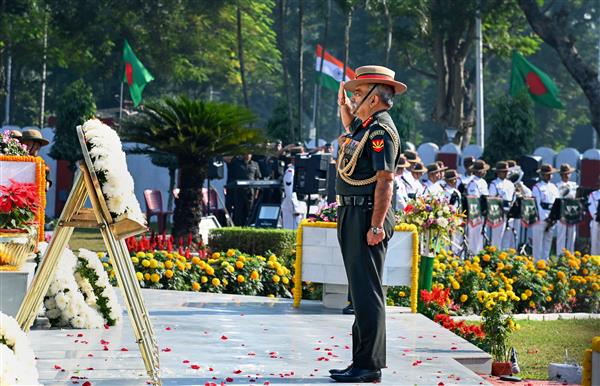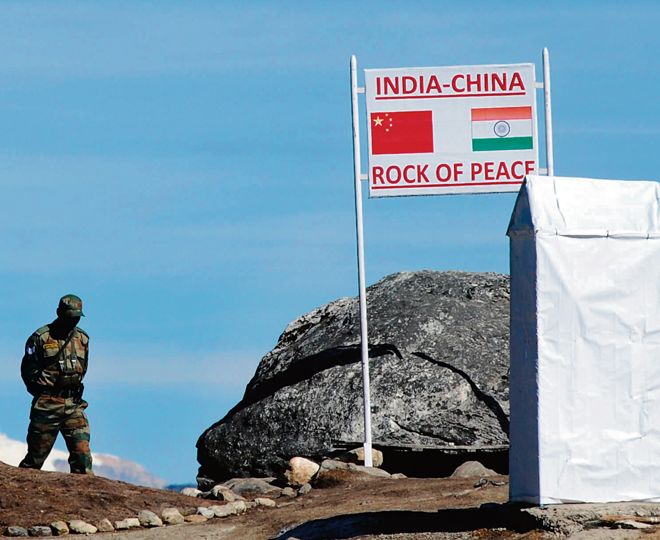Defence Minister Rajnath Singh leaves no opportunity to make public announcements that we will give a befitting reply to anyone eyeing our land. Post China’s 2020 aggression in Eastern Ladakh, he also stated in the Parliament that “we have not lost even one inch of territory” – a statement he has been repeating elsewhere. Prime Minister Modi’s remark Na Koi Aaya, Na Koi Ghusa has also been making the rounds on social media.
Articles that talked of losing control of some 1,000 sq km in Ladakh were aggressively repudiated by the mainstream media as well as by the ‘followers’ in TV debates. Concurrently, Rajnath also keeps saying that a “Free Hand” is given to the forces, which is to cover up the political pusillanimity, as would be apparent from the following.
In a recent three-day DGP-IGP Conference held under aegis of the Ministry of Home Affairs (MHA), speakers of the Central Armed Police Forces (CAPF) brought out the following:
Patrolling from the India side is restricted or there has been “no patrolling” in as many as 26 out of 85 Patrolling Points (PPs) starting from Karakoram Pass to Chumar. There is restrictive India patrolling between PPs 5-17, 24-32, 37, 51, 52 and 62.
Other than rapid infrastructure development and buildup of Chinese forces along the LAC, tough weather conditions and terrain were cited as “one of the main reasons” for lack of domination by Indian forces.
China occupies areas that have no Indian presence, which has led to shift of the border under Indian control towards the Indian side and buffer zones in all such pockets resulting in loss of Indian control in these areas.
PLA took advantage of buffer areas during de-escalation talks by placing cameras on highest peaks and is monitoring movement of Indian forces. This situation is seen at Black Top and Helmet Top in Chushul, at Demchok, at Kakjung, at Gogra Hills in Hot Springs and at Despang plains near Chip Chap River.
In December 2021, restrictions were placed on movement of Indian forces beyond Daulet Beg Oldi (DBO) towards KK Pass; it was feared that Chinese cameras would capture the movement leading to a confrontation with Chinese forces (sic).
The disengagement at PP-15 and 16 resulted in loss of pasture lands at Gogra Hills while pasture lands have also been lost in the north bank of Kakjung. This has resulted in loss of livelihood and changes in lifestyle, which has led to migration.
Use of technology, better coordination among forces and development of border villages along the LAC was cited as a way forward.
The above DGP-IGP Conference was attended by Prime Minister Narendra Modi, Home Minister Amit Shah and NSA Ajit Doval.
The government’s official narrative now stands exposed with the disclosures reportedly made by the CAPF officers. The Military remains gagged from speaking the truth and the Army kept busy with rounds of talks with the PLA despite knowing that China would not budge from intrusions made deliberately and now consolidated. Our political class and, to an extent, the mainstream media and intelligentsia have tried to show that everything is hunky dory which is hardly the case.
The resultant lack of trust by the Ladakhis in the Centre may not be visible but it would be naïve to ignore it. Similarly, what would our neighbours like Bhutan, Nepal and Myanmar be thinking of our inability to stand up to China?
With no ministry responsible for information warfare (IW), our IW appears solely focused on psyching indigenous population. An erudite scholar says that the omnipotent NSA is controlling the show notwithstanding the fact that we require a host of domain specialists, like psychologists, theme generators, mis-information handlers, social media specialists, evaluators in addition to technical hands – he seems to be all rolled into one. No wonder our effort is a ‘knee-jerk response’ and disjointed.
It is no secret that the MHA refuses to place the CAPF deployed in the show window of Ladakh under operational command of the Army and the government is sparing no effort to place the police forces above the military. Moreover, the 20-day national lockdown in 2020 denied movement of army’s reserve formations for exercising in Ladakh and China seized the opportunity.
In addition to losing control of some 1000 sq km territory, we also vacated the Kailash Range in our own territory apparently because of a Chinese threat conveyed through politico-diplomatic channels. To top this, stopping all movement from DBO towards KK Pass is pure “cowardice” – crow-flight distance between DBO and KK Pass is 17 km, road distance being 18 km. If we had the political will, we should have not only refused to vacate Kailash Range but also occupied KK Pass telling China to vacate the 20-km deep intrusion at Y-Junction in Depsang, as well as withdraw from the Indian side of Demchok.
Our border infrastructure has years to catch up not only in terms of end connectivity, but also the condition of BRO roads that are handed over to States. In a cabinet meeting under the then PM Indira Gandhi, a proposal was made to hand over the border roads to the States for maintenance. To this, the then COAS General Sam Manekshaw said yes prime minister but where will those roads be after 3-5 years. The matter was dropped. With reference to the recent clash at Yangtse in Tawang region of Arunachal Pradesh, an Australian think tank has shown that end connectivity to our posts in Yangtse are not conducive to support open conflict.
China’s infrastructure including the two bridges over Pangong Tso are clearly for offensive purposes. In addition, Beijing has announced a second highway through Aksai Chin to be completed by 2035 which would touch Galwan and Gogra-Hot Spring. Our government has chosen to ignore the Chinese intrusions and is appeasing China by giving it much more benefit in bilateral trade than it was before 2020. The hope would be that China will not aggravate the situation before or during India’s general elections in the summer of 2024.
Chinese President Xi Jinping would love out pusillanimity but Xi is in a hurry, hungry for territory-water-minerals and faces an ageing population, which implies that a clash is inevitable. Rajya Sabha MP Subramanian Swamy tweeted last year that Xi distributed maps showing Arunachal Pradesh and Ladakh part of China and J&K as part of Pakistan during the SCO Summit in Uzbekistan in September 2022, which was attended by PM Modi. This was a deliberate act indicating Xi’s resolve.
Finally, a hilarious comment on social media reads that next time Rajnath says “not even one inch of territory is lost” with reference to Ladakh, he is probably wearing diapers under his pyjama.
The author is an Indian Army veteran. Views expressed are personal.
Lt Gen Prakash Katoch
A well known special forces officer of Indian Army, Lieutenant General Prakash Katoch (R) is equally adept at writing expert and opinionated pieces on Defence Policies and Security. His Articles and Reviews are regulary. Lt Gen Prakash Katoch
Forward articles to editor@news4masses.com
Contact us: mail@news4masses.com




















































































































